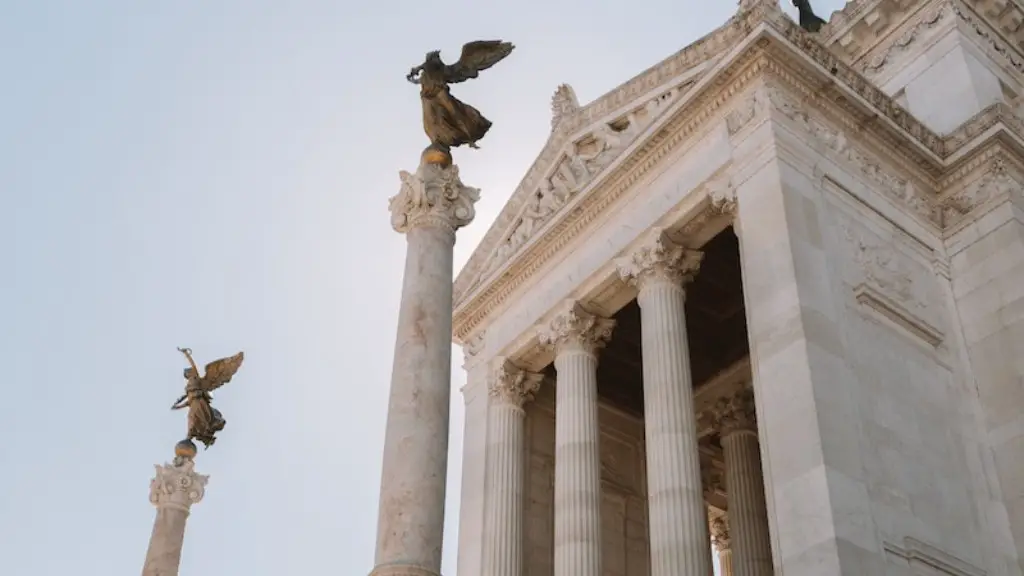History of Augury in Ancient Rome
Augury, in its simplest form, is a form of divination or prophecy used by the Ancient Romans to discover the will of the gods. It was a very important part of Roman religious life, and was said to be the most important at times. Augurs, or priests, would study the flight patterns of birds and other animals to interpret divine messages that the gods intended to convey. It was common for augurs to be consulted before major decisions were taken, such as in regards to war, the election of a magistrate or the foundation of a city.
The practice of augury dates back to the fifth century B.C.E in Ancient Rome. The significance of it was so important that it was seen as being even more potent than other types of divination such as haruspicy, which is the practice of reading the entrails of sacrificed animals. By observing the flight paths of birds and other animals, the augurs were thought to be able to discern the will of the gods.
The art of augury was complicated and included particular rules and procedures in order to be successful. The methods used included analyzing the number of animals which flew across the sky, as well as their direction and speed. Augury had to be done only in conditions that were suitable for observation, such as in a good light, with a clear sky and when the augur was in a good state of health. Certain sacrifices were needed for the augur to make and for the gods to be pleased.
After indicating the omens, augurs used a complicated system of interpreting the signs and foretelling the future. They checked the omens against the Sibylline Books to make sure there was accuracy. Through their findings, augurs were able to offer advice on the best course of action. This helped the decision-making process of Roman officials, in particular the Senate, who valued the advice of the augurs.
This practice of divination was eventually embraced by the Christian Church during the Medieval period, although with a somewhat different interpretation. Augury became associated with superstitious and occult practices and was eventually deemed as evil or forbidden by the Church. Eventually, it faded away completely as a form of divination, although there have been some attempts to revive it in modern times.
Interpretation
The interpretation of omens was a complicated and risky practice. Augurs had to be very experienced in order to be able to quickly recognize the omens and interpret their significance. Although the practice was embraced by the Roman Senate, there were still a lot of dangers that came with it. At times, it was seen as an unsubstantiated form of divination, and it was difficult to know whether it was accurate or not.
On the other hand, the results of augury were believed to bring about much more tangible results than other forms of divination. In Ancient Rome, the practice was seen as closely linked to the gods and the Senate, and it was seen as a way of connecting with the divine. This allowed a more structured approach to decision-making and gave a sense of importance to those decisions, as they now had the authority of the gods behind them.
In the past, augury has been seen as a powerful form of divination and has been used to attempt to answer some of the most important questions of the time. Despite its decline in popularity, it is still an interesting topic to explore and can offer insight into the practices and beliefs of the Romans of old.
Religion
The practice of augury was closely linked to the Roman religion. It was based upon the idea that the gods had the ability to communicate with mortals, and that by interpreting the signs from the gods, augurs could understand their will and intentions. Even though the practice was widely accepted, there were still some who were skeptical of its efficacy.
The art of augury was also seen as a way of connecting with the divine. By studying the flight of birds and other animals, augurs could interpret the will of the gods and receive messages from them. This divine connection allowed Rome to make decisions based upon the advice of the gods and the augurs.
The significance of augury was taken even further at times. In some cases, it was seen as an all-powerful form of divination that could be used to help the Romans guide their affairs. It was believed that the accuracy of the predictions made through augury was so powerful that it could even alter the future.
Symbolism
The use of augury to interpret the will of the gods had a deeper meaning behind it as well. Birds and other animals were seen as symbols of divinity and special significance was placed upon them. Even the natural process of their flight was believed to be an indication of the gods’ plans for humans. This allowed for a special connection between the gods and mortals.
The use of augury was also a way in which the Ancient Romans connected to the divine. By utilizing augurs, the Senate and other prominent figures in Ancient Rome were able to gain an insight into the will of the gods. This allowed them to make more informed decisions, as the advice of the augurs was greatly respected.
In today’s world, the practice of augury is still used by some people as a way of connecting with divinity. While it is not generally accepted in mainstream religions, it still has a place in the spiritual life of some people. Even though it is not a widely practiced form of divination in the modern world, it is still interesting to learn about the practice and the symbolism behind it.
Science
From a scientific standpoint, divination through the use of augury has not been able to be proven. It is impossible to determine whether the signs and symbols used by augurs are actually accurate or not. Despite this, it is still possible to draw some conclusions from the use of augury. It can offer insight into the beliefs of the Ancient Romans and the way in which they saw the world.
The study of augury can also reveal the complexity of the practice and the traditions that it was tied to. Not only did augurs have to learn a complex system of thought but they also had to be able to interpret the different symbols that were used in order to predict the future. This shows the importance of divination to the Ancient Romans and the thought that went into the practice.
Finally, the study of augury has been used as a way of understanding the belief systems of Ancient Rome and its surrounding cultures. It is possible to interpret the way in which these cultures viewed the world and their relationship with the gods. The use of symbols in divination can give insight into how the Ancient Romans and other cultures saw religion and the divine.
Prevalence Today
In modern times, the practice of augury is not widely accepted as a form of divination. Many consider it to be a superstitious or occult practice, and it is not often associated with mainstream religions. However, there have been attempts to revive the practice, and it is still practiced in some communities around the world.
In certain countries, augury is still seen as a legitimate form of divination and sometimes serves as a way to interpret the will of the gods. It is also still used in some cultures as a form of symbolic representation, as the flight of birds and other animals is sometimes seen as a sign of prosperity or good luck. However, these instances are not widespread and the practice is generally seen as belonging to the past.
Augury also still plays a small role in some occult practices, particularly in regards to dream interpretation. Dreams are seen as being a way in which divinity can communicate with mortals, and the flight patterns of birds are sometimes used as symbols in order to interpret the message. However, this is rarely seen as a reliable form of divination, and is instead considered more of a spiritual exercise than a form of divination.
Conclusion
The practice of augury, while being widely accepted in the past, is no longer widely accepted as a legitimate form of divination. It was a key aspect of religious life in Ancient Rome and was used as a way of connecting with the divine and interpreting their will. While it is still practiced in some small cultures today, for the most part it has been relegated to the past.





